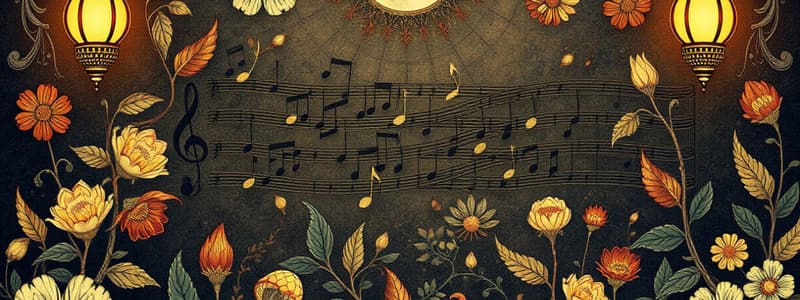Podcast
Questions and Answers
What is rhythm?
What is rhythm?
The time element, how the sound is moving through time.
What is tempo?
What is tempo?
How fast the music/pulse is moving through time.
What is a beat in music?
What is a beat in music?
Rhythmic pattern, the basic unit of measurement for time in music.
What does duration refer to in music?
What does duration refer to in music?
What is meter?
What is meter?
What is a melody?
What is a melody?
What is a pitch?
What is a pitch?
How many notes are there in the chromatic scale?
How many notes are there in the chromatic scale?
What is a scale in music?
What is a scale in music?
What is an interval?
What is an interval?
What is a tune?
What is a tune?
What is a motive in music?
What is a motive in music?
What is a theme in music?
What is a theme in music?
What is harmony?
What is harmony?
What is a chord progression?
What is a chord progression?
What does consonance refer to?
What does consonance refer to?
What is dissonance?
What is dissonance?
What is tone color?
What is tone color?
What are dynamics in music?
What are dynamics in music?
What does form refer to in music?
What does form refer to in music?
What is texture in music?
What is texture in music?
What is monophony?
What is monophony?
What is homophony?
What is homophony?
What is polyphony?
What is polyphony?
What is contemporary music?
What is contemporary music?
Who is Jennifer Higdon?
Who is Jennifer Higdon?
What is Two Steps from Hell known for?
What is Two Steps from Hell known for?
Who is Mark O'Connor?
Who is Mark O'Connor?
What is Bang on a Can All-Stars?
What is Bang on a Can All-Stars?
Who is Phil Pollard?
Who is Phil Pollard?
Who is Chris Thile?
Who is Chris Thile?
What is a movement in music?
What is a movement in music?
What are string instruments?
What are string instruments?
What are woodwind instruments?
What are woodwind instruments?
What are brass instruments?
What are brass instruments?
What are percussion instruments?
What are percussion instruments?
Flashcards are hidden until you start studying
Study Notes
Rhythm and Tempo
- Rhythm refers to the time aspect in music, crucial for movement through time.
- Tempo indicates the speed at which music is played or the pace of the pulse.
Beat and Duration
- Beat serves as the basic unit of time measurement in music, conveying rhythmic patterns.
- Duration covers the length of sound in a musical context.
Meter
- Meter organizes rhythmic patterns into phrases, defined by recurring strong and weak beats.
- Meters are generally categorized as duple, triple, or quadruple.
Melody and Pitch
- Melody consists of sequences of notes or pitches, defined by factors like pitch, note, and scale.
- Pitch is identified by a specific frequency or rate of vibration, which is fundamental to music.
Notes and Scales
- Music vocabulary includes 12 distinct notes recognized in the chromatic scale.
- Scales are collections of notes that can be major or minor based on their tonal center and mode.
Musical Elements
- An interval represents the distance between two musical notes.
- A tune comprises short phrases with equal lengths and distinctive cadences.
Motive and Theme
- Motive refers to brief musical phrases that function as foundational elements in compositions.
- Theme describes longer phrases that encapsulate the main musical idea.
Harmony and Chords
- Harmony arises from playing multiple notes together, with chords consisting of two or more notes.
- Chord progression is a sequence of chords that facilitate musical flow.
Consonance and Dissonance
- Consonance denotes harmonies that feel stable and resolved.
- Dissonance creates tension, giving a sense of instability in musical compositions.
Tone Color and Dynamics
- Tone color, also known as timbre, is essential for identifying sounds based on their quality and instrumentation.
- Dynamics pertain to the volume levels in music, with shifts like crescendo being significant.
Musical Form and Texture
- Form describes the organization of a piece, commonly seen in structures like verse-chorus or sonata form.
- Texture relates to the interplay of melody and harmony, with monophony, homophony, and polyphony as key types.
Texture Types
- Monophony features a single melody without harmonic support.
- Homophony combines a main melody with accompanying harmonies, the most prevalent texture.
- Polyphony incorporates multiple independent melodies simultaneously.
Contemporary Music
- Contemporary music merges classical with other genres, featuring composers like Jennifer Higdon and ensembles like Bang On a Can All-Stars.
Notable Composers and Characteristics
- Jennifer Higdon is known for concertos that highlight soloists within orchestral frameworks.
- Mark O'Connor's bluegrass background contributes to his versatile musical style.
- Two Steps from Hell is recognized for producing contemporary film music.
Instrument Families
- Strings include violin, viola, cello, double bass, and harp, distinguished by their pitch range.
- Woodwinds are categorized into reed instruments (e.g., clarinet, oboe, bassoon) and non-reed instruments (e.g., flute, piccolo).
- Brass instruments include the French horn, trumpet, trombone, and tuba, each with unique pitch characteristics.
- Percussion instruments are divided into pitched (e.g., xylophone, timpani) and unpitched (e.g., cymbals, drums).
Movement in Music
- A movement is a self-contained musical piece, typically part of a larger work, comprising distinct sections.
Studying That Suits You
Use AI to generate personalized quizzes and flashcards to suit your learning preferences.




